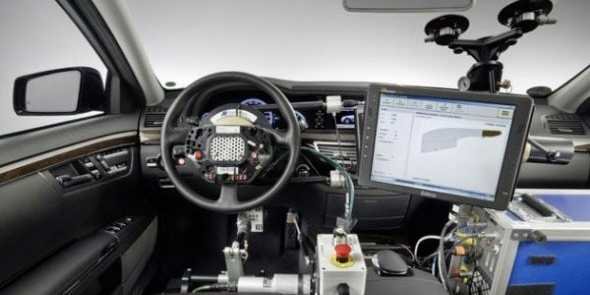Interestingly, an Atlantic article (What Jobs Will the Robots Take? January 2014) noted that self-driving vehicles were thought unworkable until very recently:
Computers that can drive cars, in particular, were never supposed to happen. Even ten years ago, many engineers said it was impossible. Navigating a crowded street isn’t mindlessly routine. It needs a deft combination of spacial awareness, soft focus, and constant anticipation–skills that are quintessentially human. But I don’t need to tell you about Google’s self-driving cars, because they’re one of the most over-covered stories in tech today.Below, the interior of Google’s self-driving car.

The latest entrant in the self-driving car sweepstakes is Uber, once a simple ride-sharing service, based on a mobile app. But now it’s moving full speed toward robotization, as signaled by the company’s scooping up of dozens of automation experts from Carnegie Mellon.
The video following says a Barclay analyst estimated a driverless Uber car would cost 58 percent less than the regular kind — yes, and thousands fewer Uber drivers getting paychecks to spend in the economy. In addition, the same analyst thought that vehicle sales might drop by 50 percent in the next 25 years. It sounds like a major transformation of society is brewing while our political leaders snooze.
So America won’t need to import thousands of turban-wearing immigrants from Asia to drive our cabs around. Right?
Uber poached a load of staff from Carnegie Mellon to help it make self-driving cars, Business Insider, May 31, 2015The world of self-driving cars is getting pretty competitive.
We’ll start seeing Google’s self-driving cars being tested on roads from this summer, with the company hoping to have one ready for public release by 2020. Tesla is also adding an ‘autopilot’ feature so drivers can take their hands off the wheel on highways later this year.
Meanwhile, Uber made its play by attracting staff from Carnegie Mellon University’s robotics department, a report from The Verge says.
People – mainly software developers at first – started leaving CMU’s National Robotics Engineering Centre (NREC) back in January. Soon, nearly a third of the department’s staff had moved around the corner to a new facility set up by Uber in a renovated chocolate factory.
All in all, 40 former NREC staff made the move. The Verge points out that some of the department’s top ranking people now work for Uber, including six out of eight of NREC’s commercialisation specialists, and Anthony Stentz, the centre’s director for the past four and a half years.
Attracting new projects to NREC usually means proving that they can be made commercially viable, The Verge’s report points out, since projects normally come to the department from external clients – like commercial companies, NASA and the military. They pay for the research NREC does and are left with a proof of concept, which they can use to produce a product on a larger scale.
In February, Uber and CMU went public with a partnership deal that was to result in joint advances in research and development for maps, vehicle safety, and autonomous driving. Uber will also fund faculty chairs and graduate fellowships for the university.
As part of the deal, The Verge reports, those moving to Uber have still been able to work on wrapping up old, NREC projects.
“The work of these employees is very incestuous and loose,” an NREC insider told The Verge. “They are given free rein of the facilities as part-time CMU employees, but there are absolutely no checks on the work that they are doing or what [intellectual property] they are taking. Is it for CMU? Is it for Uber? None of us here know.”
Uber’s self-driving car facility is growing quickly, and the company plans to move into a 53,000 square foot facility about a mile down the road from their current quarters by the end of this year.
With the competition in self-driving cars heating up, it makes sense the company would pick CMU as a partner, which has designed several automated vehicles to compete in DARPA challenges.